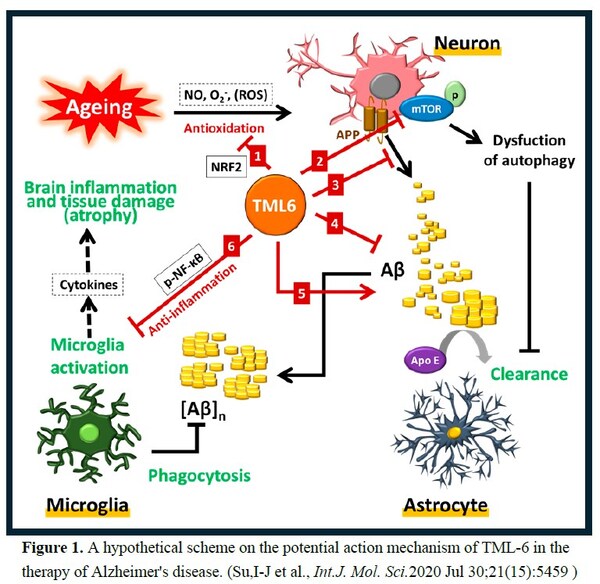预约演示
更新于:2025-05-07
mTOR x APP x APOE x NF-κB
更新于:2025-05-07
关联
1
项与 mTOR x APP x APOE x NF-κB 相关的药物作用机制 APOE激动剂 [+4] |
在研机构 |
原研机构 |
在研适应症 |
非在研适应症- |
最高研发阶段临床1期 |
首次获批国家/地区- |
首次获批日期1800-01-20 |
1
项与 mTOR x APP x APOE x NF-κB 相关的临床试验NCT06562114
A Phase 1, Safety, Tolerability, Single-ascending Dose, Multiple-ascending Dose, Food Effect, and Pharmacokinetic Study of TML-6 in Healthy Volunteers
The purpose of this study is to evaluate the safety, tolerability, single-ascending dose (SAD), multiple-ascending dose (MAD), food effect, and pharmacokinetic (PK) Study of TML-6.
开始日期2024-07-11 |
申办/合作机构 |
100 项与 mTOR x APP x APOE x NF-κB 相关的临床结果
登录后查看更多信息
100 项与 mTOR x APP x APOE x NF-κB 相关的转化医学
登录后查看更多信息
0 项与 mTOR x APP x APOE x NF-κB 相关的专利(医药)
登录后查看更多信息
1
项与 mTOR x APP x APOE x NF-κB 相关的文献(医药)International Journal of Molecular Sciences2区 · 生物学
A Curcumin Analog Exhibits Multiple Biologic Effects on the Pathogenesis of Alzheimer’s Disease and Improves Behavior, Inflammation, and β-Amyloid Accumulation in a Mouse Model
2区 · 生物学
ArticleOA
作者: Wang, Hui-Chen ; Su, Ih-Jen ; Tsai, Kuen-Jer ; Chang, Hong-Yi
1
项与 mTOR x APP x APOE x NF-κB 相关的新闻(医药)2024-06-07
TAINAN, June 7, 2024 /PRNewswire/ -- MLB (Merry Life Biomedical Company, Ltd., Taiwan: ), a biomedical company, announced that the U.S. Food and Drug Administration (FDA) has approved IND application for
TML-6, an novel drug to treat
Alzheimer's disease (AD), enabling a Phase 1 clinical trial to be initiated this July. Advancing TML-6 into clinical trial is a critical milestone for MLB to develop a new era
multi-target drug for AD since 2018.
About TML-6
Continue Reading
TML-6 is a novel synthetic curcumin analog. Professor Ih-Jen Su at Southern Taiwan University used a platform of 6 aging and AD biomarkers to screen the 12 compounds from Androscience (San Diego, USA) for AD candidate. Preclinical studies showed that
TML-6 (ASC-6) exhibits a
multi-target action mechanism for AD, including anti-aging, activation of autophagy (mTOR inhibitor), reducing amyloid accumulation, and anti-inflammation (Figure 1), the efficacy confirmed by 2 AD animal models.
TML-6 has a
high bioavailability through formulation and then completed preclinical toxicology and safety studies.
TML-6 should be potentially a novel drug to improve or
reverse the progression of early-stage AD.
The Design and Future Plan of TML-6 for AD Clinical Trial
s
TML-6 is developed as an oral drug and will conduct a SAD/MAD phase 1 clinical trial at Glendale Adventist Medical Center, LA, USA in 2024 Q3. Elderly cohort and CSF pharmacokinetics (PK) studies were specifically designed. For a global multi-site phase 2a clinical trial, several distinguished global AD experts provided consultation.
Blood biomarkers will be included in the phase 2a trial as the surrogate endpoint of efficacy. Furthermore, TML-6 is considering to combine with the current anti-amyloid drugs in phase 2 trial. The
drug combination could not only exhibit synergistic effects to improve AD behavior, reducing amyloid accumulation and ant-inflammation, but can also reduce antibody dosing to only 10% and avoid the adverse events (ARIAs) of anti-body drugs. MLB has successfully raised funds to conduct this global phase 2a clinical trial, scheduled to be conducted on 2025 Q3.
Contact:
Chien Hong Lin, PhD
Email: [email protected]
SOURCE Merry Life Biomedical Company, Ltd.

临床2期临床申请临床1期
分析
对领域进行一次全面的分析。
登录
或

生物医药百科问答
全新生物医药AI Agent 覆盖科研全链路,让突破性发现快人一步
立即开始免费试用!
智慧芽新药情报库是智慧芽专为生命科学人士构建的基于AI的创新药情报平台,助您全方位提升您的研发与决策效率。
立即开始数据试用!
智慧芽新药库数据也通过智慧芽数据服务平台,以API或者数据包形式对外开放,助您更加充分利用智慧芽新药情报信息。
生物序列数据库
生物药研发创新
免费使用
化学结构数据库
小分子化药研发创新
免费使用
